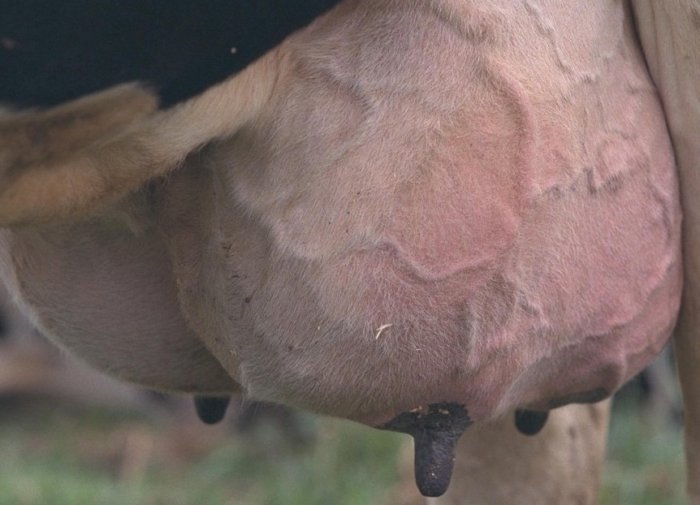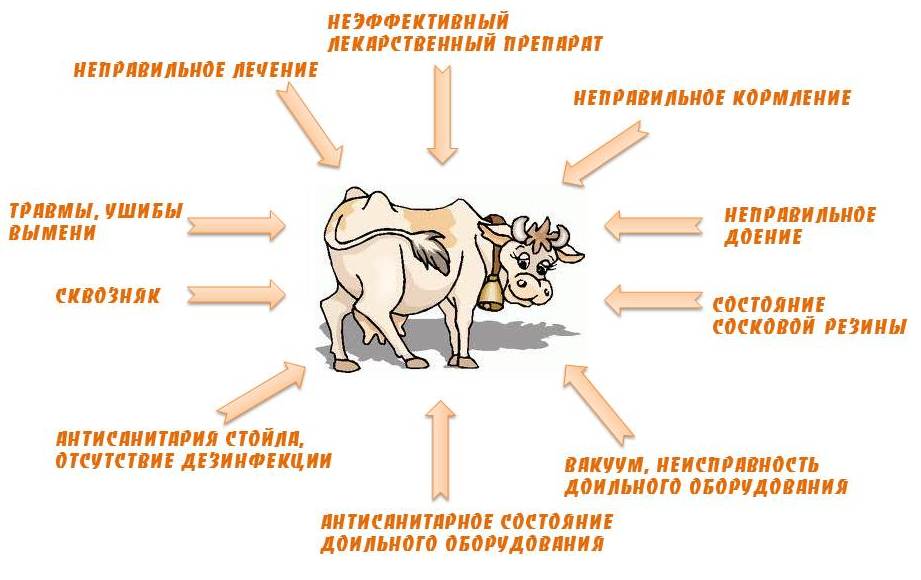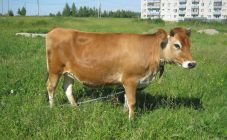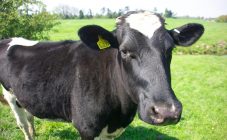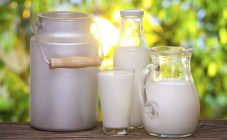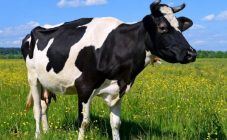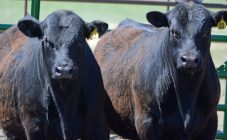Content:
In agriculture, farmers and ordinary residents that keep cattle, sooner or later, face such a problem as mastitis in cows. A mild form of the disease with timely detection is not difficult to cure. If the owner, for some reason, did not pay attention to changes in the appearance and behavior of the animal in time, then the disease will develop quickly, and soon pus will appear in the milk of the cow. Treatment of mastitis in cows is possible with both antibiotics and alternative methods, proven by generations.
How does mastitis manifest in a cow
First you need to figure out what mastitis (breastfeeding) is and what its manifestations can be seen in cattle.
Mastitis is an inflammation of the parenchymal tissue of the udder, in other words, of the mammary glands in cows, which leads to a partial or complete loss of milk yield. There are a huge number of causes of mastitis. The following can provoke it:
- infections: streptococcus, staphylococcus, coli infection (E. coli);
- non-observance of the rules of personal hygiene during milking;
- disturbances in the diet (excess of monofeeds that stimulate the productivity of cattle);
- negligence in cleaning the personal place of the animal;
- insufficient milk flow after calving;
- complications arising after difficult childbirth;
- the occurrence of endometritis (inflammation of the uterus);
- problematic exit of the placenta after childbirth;
- very high productivity of the cow;
- injuries resulting from insect bites, bruises, etc.
By itself, this disease does not pose a threat to the life of cows. It hurts the pocket of the owner of the cow, because a lot of money is spent on the medicine, and the milk becomes unusable for an indefinite amount of time for consumption and processing. That is why experienced farmers monitor the health of their wards with special care.
The disease can take two forms: open and latent. It will not be difficult to identify the open form even for beginners, that for the first time they had a cow. The latent form is more dangerous. Due to the absence of obvious signs of the disease, pets do not receive proper attention and treatment, which in turn leads to the transition of mastitis to a chronic form, and this threatens a complete loss of lactation without the possibility of recovery.
Scientists have identified the following types of mastitis and their symptoms:
- Subclinical - a form that is hidden. At home, it can only be detected with a special tester device. Before that, it is worth monitoring the milk, defending it or using the method of deep palpation. Veterinarians, when examining an animal's udder, can diagnose lumps or nodules in the mammary gland. Narrowing of the milk duct, as well as thickening of the nipple walls, can help to identify the disease.
- Chronic often does not allow itself to be detected for a long time. It occurs when a cow has a short-term inflammation of the udder, and then all symptoms disappear. Inexperienced farmers assume that the disease has gone away on its own and do not take any action to treat the animal, which is a gross mistake.At this point, mastitis becomes chronic, which threatens with constant inflammation and changes in the structure of milk. You can determine the disease progressing in the shade with a tester at home or by observing dairy products. The milk consistency will become more watery. It may also contain particles that look like flakes.
- Catarrhal is a type of disease that, as it progresses, clogs the milk ducts of cows, preventing the free flow of milk. The problem will not be noticeable for the first few days. If, after milking, a clot of casein was found in fresh milk, or it seemed to be diluted, you need to proceed with immediate treatment. Another sign of catarrhal mastitis is an enlarged udder due to milk accumulating in it.
- Purulent - characterized by purulent exudate. The milk yielded during this form of infection must absolutely not be used for food.
Purulent mastitis can take two forms:
- An abscess is the appearance of abscesses on the mammary glands. If untreated, they grow, increase in size and merge into huge wounds. At this time, the affected udder tissues cease to function normally and change their structure. This leads to the fact that part of the gland may simply stop working.
- Phlegmon is a severe form of purulent mastitis. The animal feels very bad and restless, the body temperature can reach 41 ° C, the mammary glands swell, increase in size and hurt. The milk that is extracted during this complication is gray in color and has a lot of clots. A spilled purulent focus of the connective tissue of the mammary glands is formed.
Other forms of mastitis:
- Purulent-catarrhal develops when the alveoli and ducts are infected. As a rule, it is affected by ¼ or 2/4 milk tanks. The cow's appetite disappears, her temperature rises, the general weakness of the animal progresses. The udder swells, becomes hard and hot.
- Serous mastitis in cattle is very painful. Part of the gland becomes inflamed, the effusion of its contents flows into the interalveolar tissue and subcutaneous tissue. The udder is swollen, inflamed, and reddened.
- Acute serous - differs from ordinary serous mastitis only in that half of the udder swells, and all reactions are more difficult. Milk from an animal with serous mastitis takes on a symptomatic bluish tint. Neither the calf nor the people can drink it.
- Fibrous occurs with advanced catarrhal form of the disease. It is characterized by the release of protein - fibrin. This protein accumulates in the interalveolar lumen and milk ducts. The advanced form of fibrous mastitis disrupts blood circulation in the breast tissues and promotes the development of necrosis! It is often complicated by gangrene and metastases in vital organs.
- Hemorrhagic manifests itself as crimson spots on the outside of the milk cistern. Blood enters the milk ducts, forms clots there, which clog the ducts. Milk with this form of the disease will be colored red or pink.
- Colimastic is very difficult to treat. The body becomes dehydrated, the temperature rises and body weight is lost. Lactation disappears.
- Gangrenous is the most severe type of mastitis. It begins to develop with a high blockage of the blood vessels of the animal, which disrupts blood circulation. Necrosis of the mammary gland tissue begins, which becomes blue-black. Gangrenous mastitis can be fatal to a cow if the infection spreads throughout the body. Milk from such a cow will have a disgusting smell. Flakes of protein will float in it, and it itself will acquire a green-brown color.
Mastitis in a cow: symptoms and treatment, drugs
So that the cow never knows about mastitis, the following preventive measures are taken:
- Livestock breeders study the literature related to the disease, its manifestations and possible treatment (employees are carefully checked, trained, tested their skills and abilities).
- Carefully monitor the conditions in which the cow lives, its diet and sufficient access to water (feeding with the same type of highly concentrated or silage-hay feed is prohibited, and make sure that spoiled, moldy, frozen feed does not get into the feed).
- For the prevention of mastitis and a beneficial effect on the mammary glands of animals, the cow is recommended to take daily walks at a distance of up to 5 km.
- Farmers of large livestock of cattle competently arrange buildings and monitor the premises and territory of their dairy farms (cow stalls should be spacious with good air exchange and temperature, pest control is carried out at least 1 time per month).
- All the rules for milking cows and caring for them and their udders are impeccably observed (before the procedure, it is recommended to treat the mammary glands with a monochloride solution of iodine 05-0.75% or 1% solution of chloramine B).
- In the presence of milking machines, constant disinfecting treatments are carried out (during the dry period, drugs must be injected into each ¼ of the udder: masticur, mastisan, masticide).
- In farms with a large livestock of cattle, groups for milking are strictly selected.
- There are obligatory checks of animals for the detection of various diseases and their immediate treatment (the addition of vitamin A and B-carotene to feed is a good means of prevention).
Carrying out these measures significantly reduces the incidence of mastitis in cows and reduces the losses of farms.
Folk recipes against mastitis
For the treatment of mastitis, the old grandfather's methods are well recommended:
- A medicinal decoction of nettle, yarrow and plantain leaves is mixed with red or white clay. The resulting mass is applied to the inflamed udder at night. In the morning, the leftovers are washed off with a warm decoction of dandelion and nettle.
- 40% alcoholic tincture of garlic is diluted in boiled water to obtain 5% liquid. It is injected through a syringe into the nipple canal twice a day.
- Grated carrots, like a cabbage leaf, are applied to the swollen place for a long time.
- If there are stony areas on the udder, rub a mixture of potato starch with oil into them.
- An ointment from melted lard and dried calendula flowers is spread on the udder and left until absorbed, then the procedure is repeated.
- A creamy mixture consisting of rice starch and boiled water can also treat. Warm it is applied to the mammary glands to maintain their temperature.
- An excellent non-drug remedy for mastitis is laundry soap. They rub the udder of the animal strongly and thickly to remove the seals in the mammary glands.
- Homemade camphor alcohol perfectly helps to disinfect the diseased area when applied externally to the affected lobe.
Mastiet forte: instructions for use for cows
The medication mastiet forte of Dutch production is widely known in the circles of professional livestock breeders. With its help, they fight against diseases such as:
- mastitis;
- otitis;
- dermatitis;
- balanoposthitis.
It is quite simple to use the drug, since the instructions for cows are attached to the package for the mastiet forte, which describes the algorithm of actions in absolutely clear language.The box contains 20 portioned syringes with medicinal product for therapeutic therapy, instructions for mastitis forte for cows and antibacterial cleaning wipes.
How to milk a cow after mastitis (advice from experienced veterinarians)
Finally, a few tips for breeding from experienced cattle owners:
- to activate milk flow, you can pierce a course of oxytocin (this can be done in case of loss of milk after calving);
- it is necessary to distribute after treatment gradually, checking lactation in both healthy and diseased lobes;
- it is possible to treat the loss of lactation with the help of easily digestible feed and vitamins.
Cow's milk is a unique product that can be consumed raw and used to make sour cream, cheese, butter and more. That is why it is required to monitor the living conditions of animals, their diet and health as best as possible. Professional livestock breeders who always put the well-being and needs of cows first are generously rewarded with plenty of healthy milk. And, as a result, they have the opportunity to significantly increase their capital.
